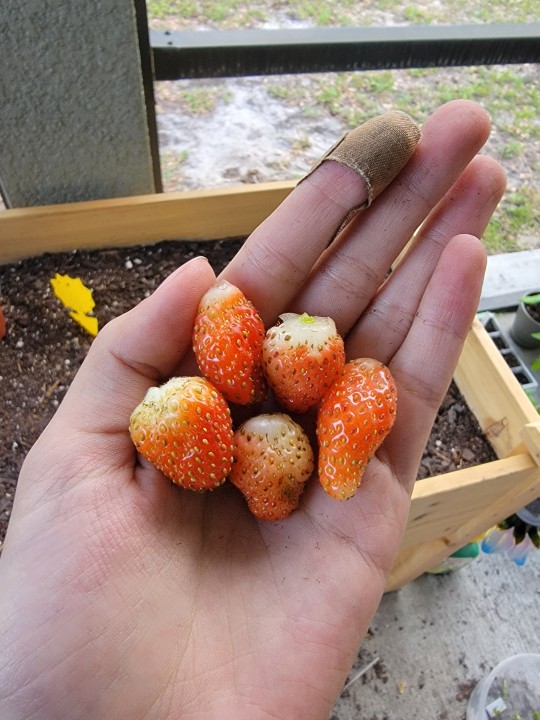#Flower gardening
Explore tagged Tumblr posts
Text
Some of you may have heard about Monarch butterflies being added to the Threatened species list in the US and be planning to immediately rush out in spring and buy all the milkweed you can manage to do your part and help the species.
And that's fantastic!! Starting a pollinator garden and/or encouraging people and businesses around you to do the same is an excellent way to help not just Monarchs but many other threatened and at-risk pollinator species!
However.
Please please PLEASE do not obtain Tropical Milkweed for this purpose!
Tropical milkweed (Asclepias curassavica)--also commonly known as bloodflower, Mexican butterflyweed, and scarlet milkweed--will likely be the first species of milkweed you find for sale at most nurseries. It'll be fairly cheap, too, and it grows and propagates so easily you'll just want to grab it! But do not do that!
Tropical milkweed can cause a host of issues that can ultimately harm the butterflies you're trying to help, such as--
Harboring a protozoan parasite called OE (which has been linked to lower migration success, reductions in body mass, lifespan, mating success, and flight ability) for long periods of time
Remaining alive for longer periods, encouraging breeding during migration time/overwintering time as well as keeping monarchs in an area until a hard freeze wherein which they die
Actually becoming toxic to monarch caterpillars when exposed to warmer temperatures associated with climate change
However--do not be discouraged!! There are over 100 species of milkweed native to the United States, and plenty of resources on which are native to your state specifically! From there, you can find the nurseries dedicated to selling native milkweeds, or buy/trade for/collect seeds to grow them yourself!!
The world of native milkweeds is vast and enchanting, and I'm sure you'll soon find a favorite species native to your area that suits your growing space! There's tons of amazing options--whether you choose the beautiful pink vanilla-smelling swamp milkweed, the sophisticated redring milkweed, the elusive purple milkweed, the alluring green antelopehorn milkweed, or the charming heartleaf milkweed, or even something I didn't list!
And there's tons of resources and lots of people willing to help you on your native milkweed journey! Like me! Feel free to shoot me an ask if you have any questions!
Just. PLEASE. Leave the tropical milkweed alone. Stay away.
TLDR: Start a pollinator garden to help the monarchs! Just don't plant tropical milkweed. There's hundreds of other milkweeds to grow instead!
#milkweed#monarchs#monarch butterfly#pollinator garden#pollinator gardening#outdoor gardening#gardening#flower gardening#out of queue#ani rambles
20K notes
·
View notes
Text

#flowercore#wildlife#fairycore#natureposting#naturecore#nature#flower garden#flower gardening#native gardening#native flowers#nature aesthetic#aesthetic#forest#flowers#wildflowers#cottage garden#cottage aesthetic
41 notes
·
View notes
Text
Milkweed Lovers Everywhere, Heed My Warning
By all means let me know if I'm wrong here, but if I'm not wrong then we're looking at a serious (at least to me) problem.
I've been trying to stray away from Tropical Milkweed (Asclepias curassavica) and towards more native species in my area--things like swamp, sandhill, etc--and Butterflyweed (Asclepias tuberosa) fits in that category for me. It's hard to find native milkweed plants in stores--even places I've gone to in the past that had a handful of native species are currently only selling Tropical Milkweed. Even still, I know that there's been a good bit of buzz around growing native species, and some stores I've visited have said they're trying to find vendors with native species--they're not only selling Tropical for lack of trying.
So imagine my surprise--and delight--when I go to Lowe's and see Asclepias tubersoa blazoned on a plant label!
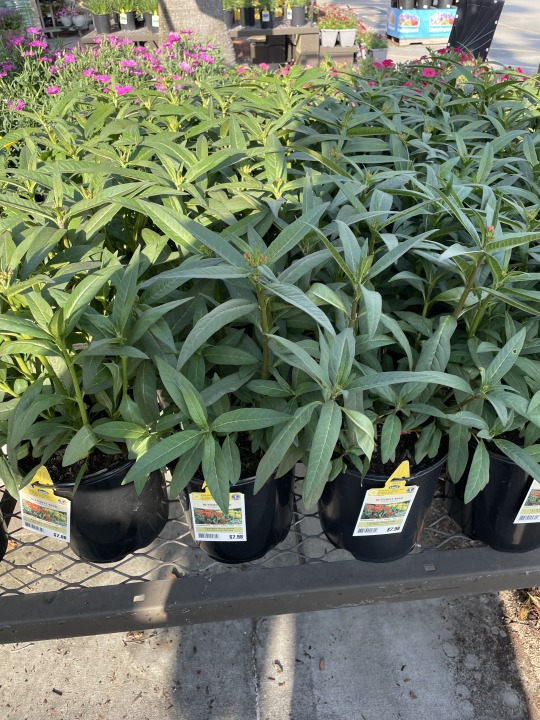
And imagine my surprise when it's being sold right next to Tropical Milkweed and looks almost identical to it.
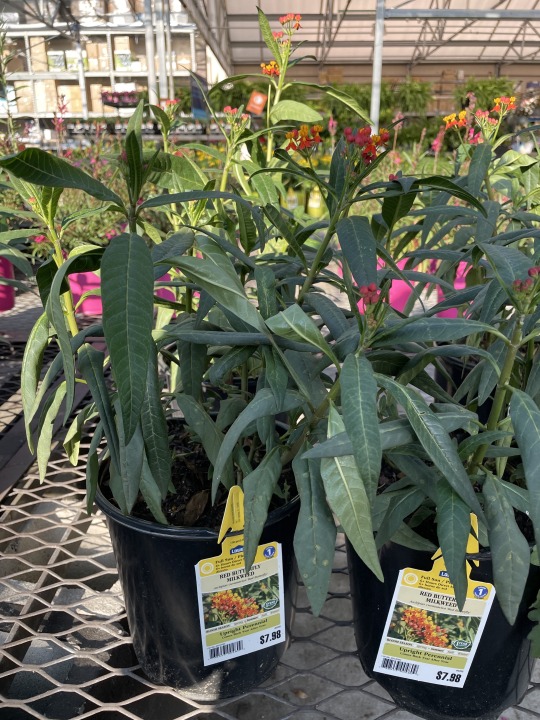
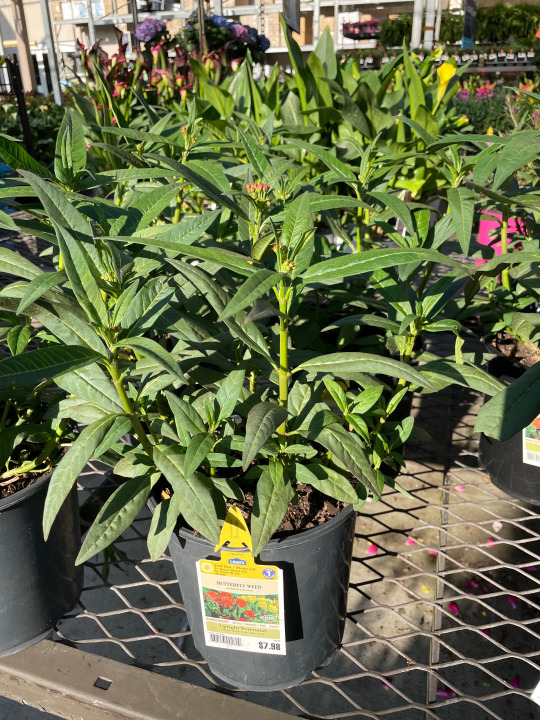
I was immediately suspicious--especially considering the red flower buds on the 'Butterfly weed'. I've grown Tropical Milkweed for several years, and while it's been awhile since I've seen a Butterfly Weed plant outside of a photograph, these definitely didn't look like what I'd seen. Not to mention, I'd only heard of Asclepias tuberosa flowering in orange or yellow--not red. Of course, at the same time, I'm not a professional botanist, and a quick google search did declare that butterfly weed can grow in red (though the images all look like asclepias curassavica to me...).
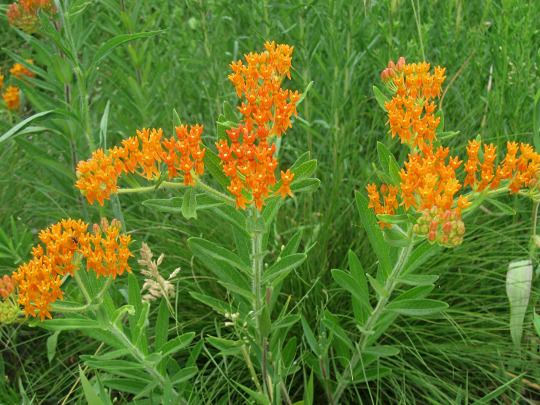
(Image from the Native Plant Database. Looking at this picture, I should've realized where this was going sooner...)
So I did the reasonable thing and bought two of them. I figured if the red buds somehow turned orange and were actually Butterfly Weed, then I'd be perfectly satisfied. If they turned out to be Tropical Milkweed, well, I simply would give them to my neighbor who's fond of them, or find something else to do with them.
(I feel the need to emphasize; there are a lot of people online who are in the 'if you plant tropical milkweed you're a horrible person and intentionally killing monarch butterflies' camp. I am not one of them; it's not invasive in my area of Florida, it just takes a little bit of extra managing in terms of cutting it back in October/November.)

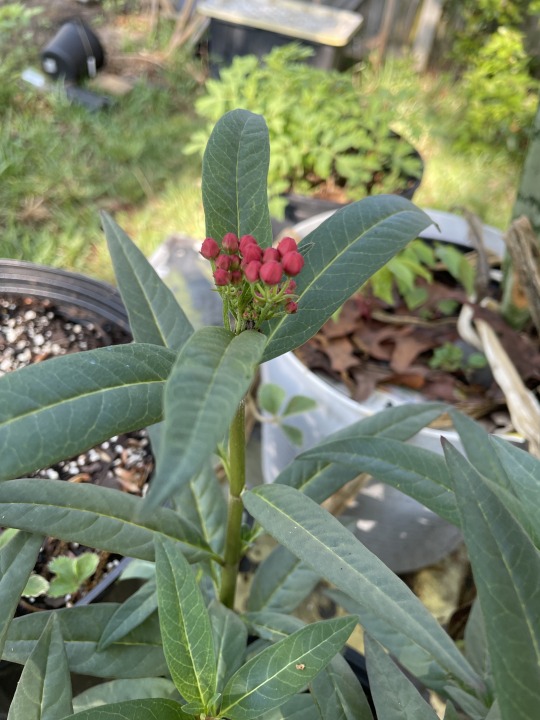
I ended up in the same Lowe's again today, shopping for my mom, and took a peek at their plant selection. Lo and behold, I found the Butterfly Weed, and...
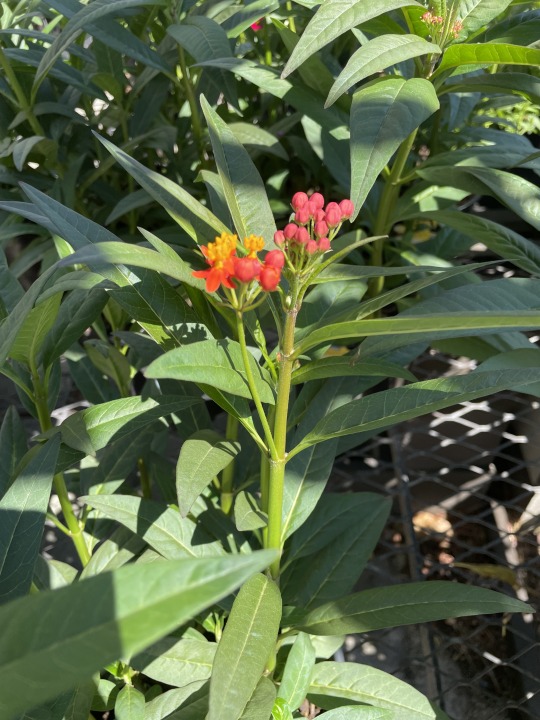
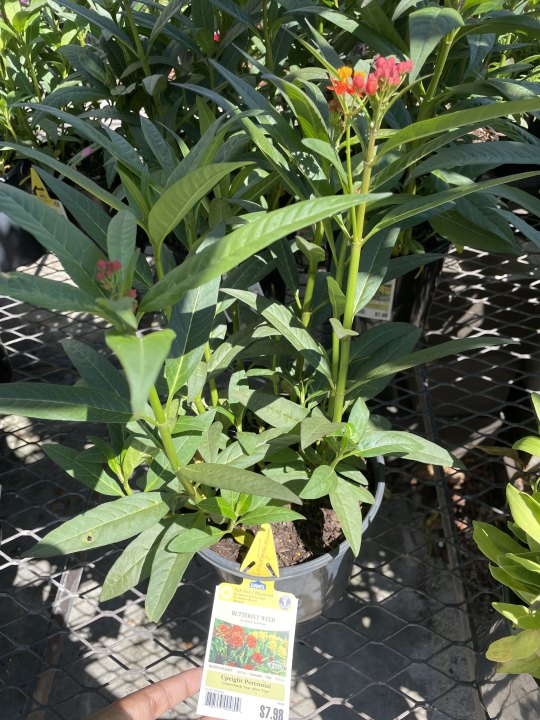
This sure does look like Tropical Milkweed to me, and to others in my gardening server, yet it's still labeled as 'Butterfly Weed.' Also, I didn't see any Tropical Milkweed on any of the shelves--at least, nothing labeled as Tropical Milkweed. Instead, all I saw was Tropical Milkweed disguised as Butterfly Weed.
This is, in my humble pollinator garden enthusiast opinion, a problem. At best, Lowe's--or the company they source their plants from--is mislabeling their plants on accident. Which could cause problems if people are buying the plants and putting them in a place that's not quite the right condition for them, or create severe disappointment if someone's excited to grow the native Asclepias tuberosa only to end up with something else entirely. At worst? Lowe's--or the company they source their plants from--are aware that people want to grow native milkweed and are either unable to or too lazy to grow them, and would rather try to get away with selling Tropical Milkweed--which has been growing increasingly controversial in some gardening circles--and still reap the benefits and profits of selling native milkweed species.
However, I'll be real? I'm not sure what exactly to do about it. So I guess I'm just letting everyone know; if you see 'Butterfly Weed (Asclepias tuberosa)' in your local Lowe's, at least double check. Otherwise, you may plant Tropical Milkweed/Scarlet Milkweed (Asclepias curassavica) instead.
#milkweed#gardening#flowers#pollinator gardening#pollinator garden#Lowe's#tropical milkweed#butterfly weed#asclepias curassavica#asclepias tuberosa#outdoor gardening#flower gardening#ani rambles#out of queue#idk how legible this post is but I hope its at least SOMEWHAT legible yknow?
938 notes
·
View notes
Text

Here's a picture of a small section of my German Iris bed. Well, what was my German Iris bed. I got hit with Iris borer grubs last year and decided to do some eco friendly gardening by digging the Irises up, bare rooting them, picking out the grubs, replanting in a new bed and cutting the leaves all the way back during the early fall. It wasn't a bad infestation, so hopefully I managed to get rid of them!
#art#artistontumblr#originalphotography#photography#flower#flowers#bloomscrolling#flowerphotography#flowerlovers#FleurFantasy#bloom#floral#inspiration#aesthetic#beauty#flowergardens#nature#naturephotography#sofiimagines#flower gardening#pest control
21 notes
·
View notes
Text

Sunflowers in my garden.
42 notes
·
View notes
Text
gardening update 02/25/25 🌿🌻🌷

i've been slowly tidying up the original flower beds that i made when i first started getting into gardening. i put down cardboard about two months ago and wet it thoroughly so it'd start breaking down, then i eventually added garden soil, and i've been adding seeds that require/benefit from cold stratification. so far, i've planted lavender, assorted poppies, joe pye weed, bee balm, and as of today, i tossed around a northeast native flower seed mix (photo of the seed packet with all the flowers included is below).

now, i want to clean up the garden bed next to this one, but i have been pretty busy with my new job, so i haven't really been home during the daytime unfortunately. here's a photo of how it currently looks:

there's a lot that i need to do for this bed. i need to pick out all the trash that has been left in it (i find that our maintenance workers or somebody maybe our neighbor has been leaving snack wrappers around and they usually find themselves in my garden which sucks), pull out the weeds and ivy, put down cardboard, add more garden soil, and create a bed divider with spare wood eventually. it's a lot but i want to do it before the last frost, so i can jump right into using it in the spring and hopefully plant some cold stratified seeds if i get it done earlier.
#hobby: gardening#gardening#gardenblr#garden blog#garden#gardener#flower bed#flower gardening#seed starting#seeds#seed#garden update
13 notes
·
View notes
Text
Such beauty on this planet
CC
#fly#sky#wings#butterfly#bug#bugs#insect#glider#butterflies#glide#flower garden#flower gardening#flower#floral#cash flow#flowers#flo welch#flowey undertale#order flow#sketch#sunset#sunrise#sun and moon show#sunday#sunglasses#leaves#leaf#living#life#love
9 notes
·
View notes
Text
Wild Prince (by: Garden of Eve)
The wind today made for some cool ripples on the pond with the Prince enjoying it all.

#garden of eve#my garden#flower garden#flower gardening#gardens on tumblr#nature#i love frogs#frogs#water garden#photographers on tumblr#pond#psycheledic
68 notes
·
View notes
Text
Fast Growing Vegetables You Can Grow In Under 60 Days
Gardening is a rewarding hobby that not only provides fresh produce but also offers a sense of accomplishment. For those who are impatient or have a short growing season, fast-growing vegetables are a perfect solution.
Many vegetables can be harvested in under 60 days, allowing you to enjoy homegrown produce quickly. Here are some top choices for fast-growing vegetables, along with tips on how to grow them successfully.

1. Radishes
Growing Time: 20-30 days
Radishes are one of the quickest-growing vegetables, often ready to harvest in just three to four weeks. They thrive in cool weather, making them ideal for spring and fall planting.
Radishes prefer loose, well-drained soil and full sun. Plant seeds about half an inch deep and one inch apart. Water regularly to keep the soil moist, and thin seedlings if they become crowded to ensure proper growth.
2. Lettuce
Growing Time: 30-45 days
Lettuce is a versatile leafy green that grows rapidly. There are various types of lettuce, including leaf, romaine, and butterhead, all of which can be harvested in under two months. Lettuce prefers cool weather and partial shade, especially in hotter climates. Sow seeds directly into the soil, about a quarter-inch deep, and thin the seedlings to give each plant enough space. Regular watering is essential to keep the leaves tender and sweet.
3. Spinach
Growing Time: 35-45 days
Spinach is another fast-growing leafy green that is packed with nutrients. It grows best in cool weather and can be planted in early spring or fall. Spinach seeds should be sown about half an inch deep and spaced an inch apart.
Thin the seedlings to allow for proper growth. Spinach requires consistent moisture and well-drained soil. Harvest the outer leaves as needed, or cut the entire plant when it reaches maturity.
4. Arugula
Growing Time: 30-40 days
Arugula, also known as rocket, is a peppery green that adds a unique flavor to salads. It grows quickly in cool weather and can be planted in early spring or fall. Arugula seeds should be sown about a quarter-inch deep and spaced an inch apart. Thin the seedlings to allow for adequate growth. Arugula prefers well-drained soil and regular watering. Harvest the leaves when they are young and tender for the best flavor.
5. Green Onions (Scallions)
Growing Time: 50-60 days
Green onions, or scallions, are easy to grow and can be harvested in about two months. They can be planted in early spring or late summer for a fall harvest. Sow the seeds about a quarter-inch deep and space them an inch apart. Green onions prefer full sun and well-drained soil. Keep the soil consistently moist for the best growth. Harvest when the green tops are about six inches tall.
6. Bush Beans
Growing Time: 50-60 days
Bush beans are a great choice for a fast-growing vegetable that produces a generous harvest. They thrive in warm weather and should be planted after the last frost. Sow the seeds about an inch deep and three inches apart. Bush beans prefer full sun and well-drained soil. Water regularly, especially during flowering and pod development. Harvest the beans when they are firm and crisp.
7. Zucchini
Growing Time: 50-60 days
Zucchini is a prolific summer squash that grows rapidly and produces abundant fruit. Plant zucchini seeds directly in the garden after the last frost, about an inch deep and spaced two to three feet apart. Zucchini needs full sun and well-drained soil. Water consistently and mulch around the plants to retain moisture. Harvest the zucchini when they are six to eight inches long for the best flavor.
8. Turnips
Growing Time: 40-60 days
Turnips are a versatile root vegetable that can be harvested for both their roots and greens. They grow best in cool weather and should be planted in early spring or late summer. Sow the seeds about half an inch deep and spaced an inch apart. Thin the seedlings to four inches apart once they start growing. Turnips prefer well-drained soil and consistent moisture. Harvest the roots when they are about two to three inches in diameter.
Growing Tips For Success
Soil Preparation: Ensure your soil is well-prepared before planting. Loosen the soil and add compost or organic matter to improve fertility and drainage.
Watering: Consistent watering is crucial for fast-growing vegetables. Keep the soil evenly moist but not waterlogged to prevent root rot and other issues.
Sunlight: Most fast-growing vegetables require full sun, which means at least six hours of direct sunlight per day. Choose a sunny spot in your garden for planting.
Succession Planting: To ensure a continuous harvest, practice succession planting by sowing seeds every few weeks. This way, you'll always have fresh vegetables ready to pick.
Pest Management: Monitor your garden for pests and take action as needed. Use organic pest control methods, such as neem oil or insecticidal soap, to protect your plants.
Conclusion
Growing fast-growing vegetables is a fantastic way to enjoy fresh produce quickly. With a little planning and care, you can have a bountiful harvest in under 60 days. Whether you have a large garden or just a small space, these vegetables are perfect for any gardener looking to maximize their growing season. Happy gardening!
#canning & preserving#companion planting#container gardening#flower gardening#herb gardening#indoor gardening#organic pest control#vegetable gardening
6 notes
·
View notes
Text

🌸🌱 "From Blooms to Seeds: It’s Easy!" 🌱🌸 Your Gomphrena garden starts here! 🌼🌿 Find out how to gather, save, and store these magical seeds ✨—keeping your garden blooming season after season! 🌸💖
➡️ Click for step-by-step instructions: How to Collect and Store Gomphrena Seeds!
💬 Comment below your seed-saving tips!
#gardening#garden#gardening tips#lovegardening#organic gardening#backyard#gyo#gardening uk#gardenchat#Gomphrena flower seeds#Collecting seeds#Storing seeds#Gardening tips#Seed saving#Flower gardening#Seed harvesting#Growing Gomphrena#Seed storage#DIY gardening#Sustainable gardening#Home gardening#Urban gardening#Seed collection#Garden tips#Plant care#Gardening tutorial#Seed preservation#Garden hacks#Seed propagation#flower
1 note
·
View note
Text
Off topic but to anyone who’s struggled to grow Lavender. Oh my god.
I love lavender! I’ve tried growing it basically every year since I started gardening! I love the color, the smell, and how much pollinators like it. But every year, it would die the instant I tried to repot it. The issue is, it doesn't like to have 'wet feet' (basically stay in wet soil for long), but as a Floridian... yeah. I tried in-ground, I tried potting soil, I tried mixing potting soil with sand. No dice.
This year a cashier at a gardening store suggested I try fucking SUCCULENT SOIL.
And its doing WONDERS.
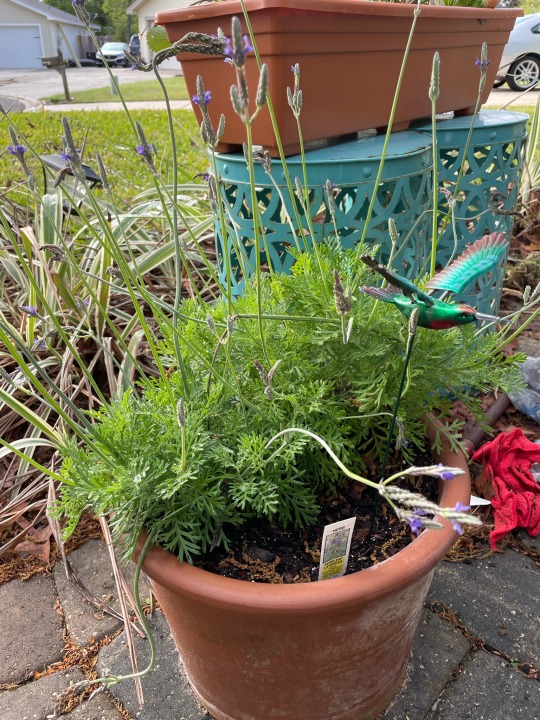





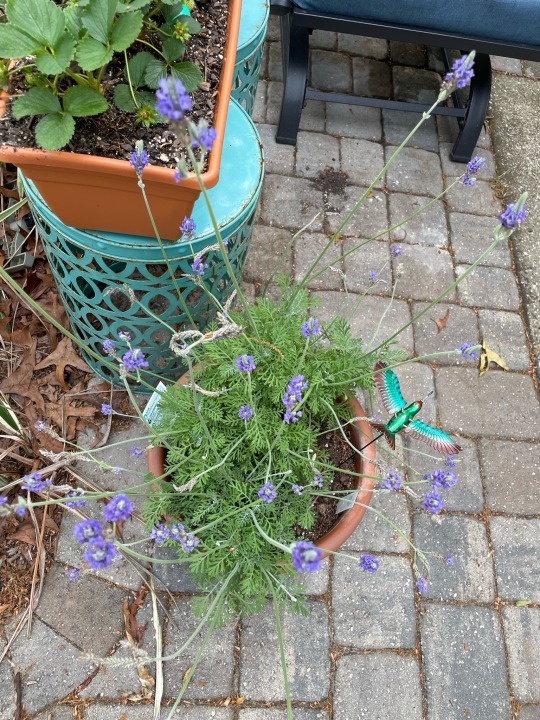

Gaze upon my lavender plants in AWE! They aren’t dying, they aren’t wimpy and weak, they are THRIVING in their environment! All because of succulent soil!!!
Granted, we'll have to wait until the summer stormy season starts to see how they do with tons of rainfall, but as it stands so far? I wish I knew this sooner, so I'm telling you now!!!
#gardening#lavender#flowers#purple flowers#lavender flowers#growing plants#outdoor gardening#pollinator gardening#pollinator garden#homies it's been like a month of having lavender in succulent soil and theyre doing SO WELL#im SO STOKED ABOUT THIS#out of queue#ani rambles#flower gardening
272 notes
·
View notes
Text

I went to a plant swap today! Got to chat with some gardening ladies, gave away some mint & comfrey & Jerusalem artichokes, plus field pea seeds, and picked up some fun stuff for my gardens.
Left front is borage (Borago officinalis), which I've grown before & found to be easy & nice to have, though I don't particularly want to eat the leaves. They taste nice, but they're unpleasantly fuzzy. Perhaps I'll do fancy things with the flowers - bees like them, too!
Back left is a couple of sweet peppers - "Lipstick" variety, I think.
Big guys in the middle are swamp sunflower (Helianthus angustifolius) and blue mistflower (Conoclinium coelestinum), and behind those are hiding a couple of little pink coneflower plants (Echinacea sp.).
On the bottom right, two Amish paste tomatoes.
I'm not sure where I'll put the flowers yet - start a flower bed somewhere, or just in the fenced vegetable garden where they won't be in danger of getting mowed? - but they can sit in their pots for a few days while I decide.
13 notes
·
View notes
Text

Sofi Red Roses, 06-02-2022 Digital Photography
#flowers#flowersmakemehappy#roses#photography#visualartist#originalart#flower friday#bloomscrolling#flower gardening#gardening#horticulture#garden#keepblooming#onlyflowers#art#visualart#flowerphotography#floralphotography#flowertherapy#colormyworldinblooms#mybloomingworld#flowertonin#flowergardening#gardeningmakesmehappy#ArtYear#sofiimagines
9 notes
·
View notes
Text

A few of my Fall Phlox beginning to bloom. I transplanted several large bunches last year so I don't expect those plants to bloom until then. This phlox variety grows to about 3-4 ft. tall and they enjoy fertile soil.
#phlox#whitephlox#whitephloxflowers#flowerbeds#flowers#blooms#perennials#perennialgarden#gardens#backyard#lateflowering#eastkootenays#eastkootenayliving#elkvalley#gardening#flower gardening#beautiful flowers#plants#fallphlox
7 notes
·
View notes


